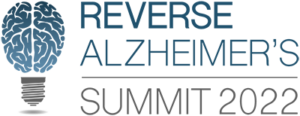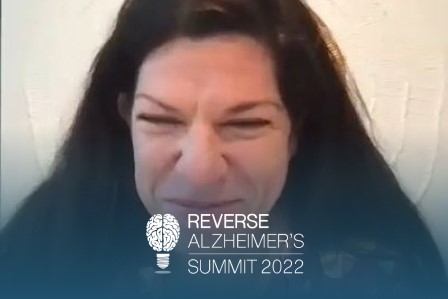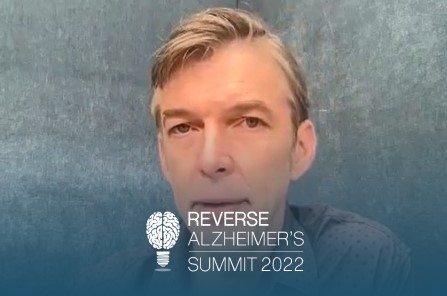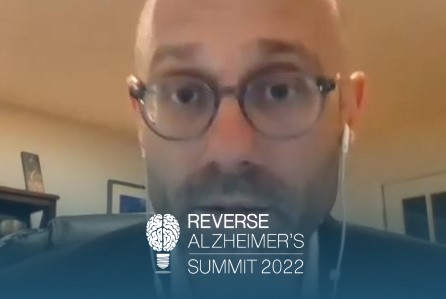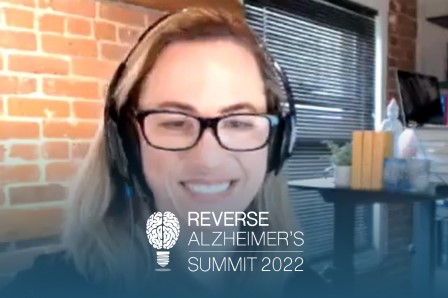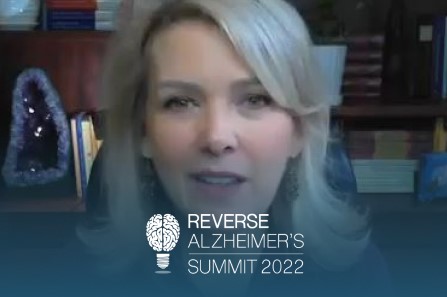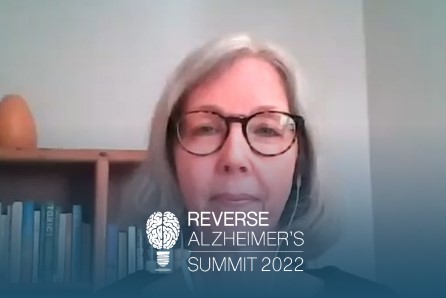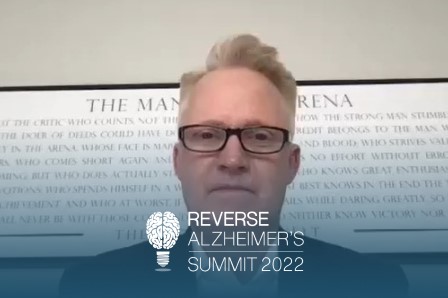Join the discussion below

Dr. Heather Sandison is the founder of Solcere Health Clinic and Marama, the first residential care facility for the elderly of its kind. At Solcere, Dr. Sandison and her team of doctors and health coaches focus primarily on supporting patients looking to optimize cognitive function, prevent mental decline, and reverse... Read More
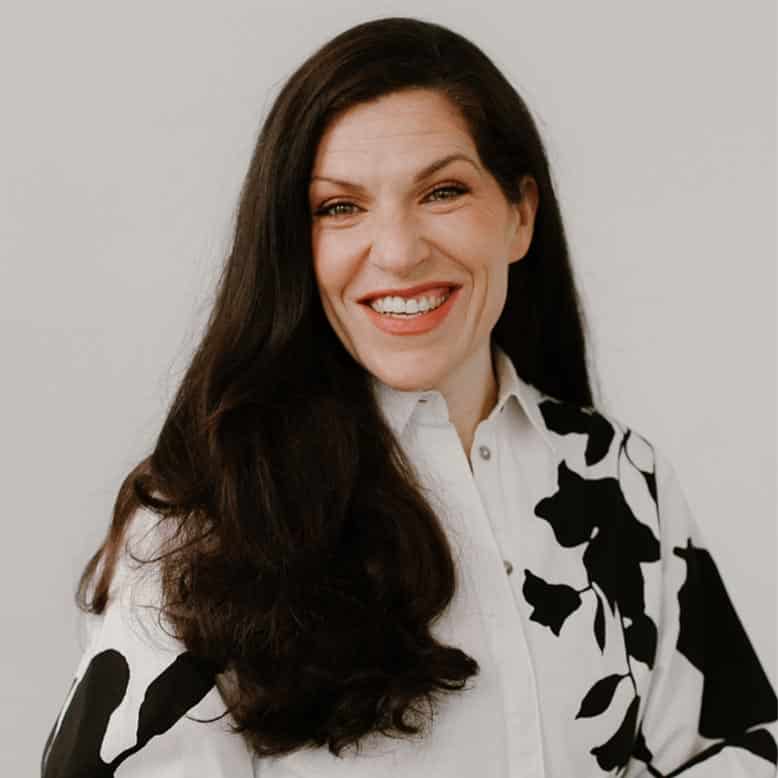
Dr. Christine Schaffner is a board-certified Naturopathic Doctor who has helped thousands of people recover from chronic or complex illnesses. Through online summits, her Spectrum of Health podcast, network of Immanence Health clinics, and renowned online programs, Dr. Schaffner goes beyond biological medicine, pulling from all systems of medicine and... Read More
- Putting the pieces together – oral and sleep hygiene.
- Avoiding the worst brain toxins.
- Mental health for brain health.
Heather Sandison, N.D.
Welcome to this episode of the Reverse Alzheimer’s Summit. I’m so excited to introduce you to my friend and colleague, Christine Schaffner. She’s a board certified naturopathic doctor who has helped thousands of people recover from chronic or complex illness. Through online summits, her Spectrum of Health podcast, network of eminence health clinics, and renowned online programs, Dr. Schaffner goes beyond biological medicine, pulling from all systems of medicine and healing modalities, helping her patients to reclaim their wellness and reveal their brightest light yet. She also trains providers. And I feel so fortunate to have her here tonight. Thank you so much for joining us.
Christine Schaffner, N.D.
Oh, thank you so much for having me.
Heather Sandison, N.D.
So what really made me wanna reach out to you was that you have a brain hygiene guide and we are here to talk about the brain, how to prevent and even reverse cognitive decline. So where do you start when it comes to healing the brain?
Christine Schaffner, N.D.
Yeah, it’s a great question. And I’m so glad that you’re doing this summit, ’cause I feel in modern life, our brains are increasingly more and more in trouble. And with the work you do, I think all of us who love this work, we wanna support our patients in aging gracefully and having their elder years be some of the best, most rewarding time in their life. And I think it’s so heartbreaking to see so many people in an increasing rate lose that ability to connect in the way that they know how and utilize all their wisdom that they learned throughout their life. And so I’m really grateful for the work you’re doing and I think it’s so important. And if you’re listening out there and don’t have any symptoms, I think all of us have to be aware, and all of us have to live a lifestyle of being aware of the things that I think we’re up against in what I call the modern terrain, right? So we live in this time that we are just unfortunately assaulted by a lot of environmental factors that over time can be bioaccumulate in the central nervous system, in the peripheral nervous system, can be what we call neurotoxins. And neurotoxins, I think, are at the root of a lot of the neurological symptoms that we see today. And I’m happy to go through that. So when I think about healing the brain and recovering the brain, I do my checklist. And one of the things that we can ignore, especially with my view of, I love studying and educating people about bioregulatory medicine, and this is a form of medicine that came outta Europe, and it’s really just another lens to look at the body. But the premise of bioregulatory medicine is that the body is always trying to self regulate and heal no matter what’s going on. And so if we have states of disease or imbalance, something is interfering with that capability for the body to regulate and adapt and be resilient in light of life stress.
And so, again, whenever we’re thinking of the brain and our overall health, I know that you probably have educated about this too, is about the dental connection. And so that’s one of the first things I just ask people about their dental history and we just do that checklist, have you, or do you have amalgam fillings. So if you do have them, we help you get rid of them. If you had them, that’s step one, but we need to also support that neurotoxicity that’s a bioaccumulated over a lifetime of the amalgam and help to reduce that. And we can talk a little bit about that. We look at root canals and we look at cavitations. So we’re looking at basically either diseased kind of nerotic bone or root canals that can harbor infection. And we know there’s a huge oral connection of the oral microbiome, and I know that they’ve even linked to certain oral microbes to cognitive decline. So it’s a very important connection I feel. So we look at the mouth, I also look at the sinuses, and I know you’ve studied with Dr. Bredesen and know the whole connection between inhale Alzheimer’s and that our environment impacts our brain in so many ways. So it’s not only the environmental factors of mold, but also what can disrupt the sinus microbiome. And what can basically create what I think of as sinus dysbiosis, whether that’s bacterial overgrowth or fungal overgrowth. And then just think of anatomy, right? Basically there’s an entryway into the brain through the sinuses, so we know we can get infections into the brain, through the sinuses. And so if we have kind of a factory of dysbiotic flora that could be leading to brain inflammation and cognitive decline. So I’m thinking of those things, Heather.
When I’m going down my checklist, I’m like, okay. What’s going on in the mouth? What’s going on in the sinuses? I don’t want that to interfere for the deeper work that we need to do. And so the next big thing that I’m really a big proponent of educating people about is the lymphatic system. And when we think about brain health, we think about the glymphatic system. So a big key of having a healthy brain and recovering someone’s brain is making sure their lymphatic system is basically draining and working well especially at night when we sleep. And this is why sleep is so important for many reasons. But we need to have deep sleep and REM sleep in order for our glymphatic system to work. And I can describe this in more detail or not. But the Cliff notes is our brain shrinks at night and lymph bathes our neurons and removes waste. And if that’s not happening, then we can have a buildup of amyloid beta or other toxicants or microbes that are gonna create over time neurodegeneration. And so that is the backdrop that I’m always looking at, mouth, sinuses, glymphatic system, lymphatic system, when I’m thinking about, okay, what’s next? And I know I can keep going on and on. And so I’m happy to pause and then we can talk about what gets into the brain that really disrupts, communication networks and leads to unfortunately neuronal cell death and cognitive symptoms.
Heather Sandison, N.D.
I’m so glad that you’re bringing these things up because it’s absolutely critical to brain health that our gut health is good. And gut health starts in the mouth, starts in the sinuses. These are all connected. And so thank you for highlighting that. Our friends and colleagues are also on here. Chip Whitney is a medical doctor who talks extensively about oral health and the connections between dental health and brain health. And so head on over his talk on this summit. And then also Dr. Tom is talking about the glymphatic system in lots and lots of detail. He teaches on this subject. So anybody who’s interested can dive into those subjects in more detail. And I wanna keep going with you on the next steps of what we can do. It sounds like you’re alluding to maybe some toxins that can start to interfere with cognitive function, so go for it.
Christine Schaffner, N.D.
So when we look at the things that we’re bombarded with that can become neurotoxins and so neurotoxins have an affinity for neurons so they’re what we call lipophilic so they’re fat loving and get basically embedded in neuronal tissue or our brain essentially. And when that happens that can bioaccumulate over time and that disrupts communication networks in the body and disrupts cellular function. And then you see basically this slowing down of transmission of neuronal signals and slowing down of cellular communication. And it just leads to the slowing down and breakdown of communication. And neurons die and that leads to these symptoms that we see, right? So there’s some big buckets that we look at and heavy metals are obviously a big bucket that we look at when we’re thinking about healing the brain and recovering the brain. And we think about, I’ve already mentioned mercury. We know mercury is a known neurotoxin that affects astrocytes, it can create a lot of inflammation in the brain. We know lead is a big one as well. We even test our children, when they’re very young for their lead levels in the blood because we know that that can damage their IQ once they get lead in the brain. So lead is very important to look at. And then I wanna highlight aluminum, ’cause aluminum I think is a very important heavy metal to be aware of. And we’re really kind of in this age of aluminum, there’s even a documentary called The age of Aluminium. It’s made in Europe. And it essentially talks about how in our food system, it can be in our water, it can be our medications, potentially in our air. And aluminum can be highly inflammatory and definitely when it gets into the brain, it can be associated with symptoms of the autism spectrum, as well as in Alzheimer’s and cognitive decline.
There’s a professor Chris Exley at the University of Keele and he’s looked at postmortem of the brains of patients with Alzheimer’s and they had a statistically significant more aluminum in the brain. And so aluminum can create what we call neurovascular inflammation and it can be, again, creating a lot of inflammation and leading to cognitive decline. So I think aluminum is something to be aware of. How we get rid of aluminum and how we get things outta the brain, though, I’ll maybe talk about that together with detox strategies, but it’s something to be aware of. And feel empowered to just start looking on in your life and how you can reduce exposure, ’cause that’s a really big part of treatment, try to reduce exposure as much as possible. So heavy metals are very important. And then I also think when we’re thinking about, I could go in two different directions, let me just go in the toxicants right now. So we got heavy metals. We also have I think I would consider electrosmog an environmental toxicant that can be a neurotoxin right now. So we think about cell phones and wifi and things that have us highly interconnected and make our life really exciting in a lot of ways, but they don’t come without a cost.
And I think that we’re learning more and more how they can disrupt our brain health through the work of Dr. Martin Pall and his work with looking at how it increases a lot of something called peroxynitrite that can be highly inflammatory in the brain and also can deplete melatonin and glutathione levels. So thinking about that, glyphosate is an active ingredient around them and there’s so much awareness over the last 7 or so years around this molecule that is really ubiquitous in our environment and I think part of our terrain that is leading to a lot of the illnesses that we both see on a day in day out basis and glyphosate can obviously disrupt our gut microbiome, but there is Dr. Stephanie Seneff and Anthony Samsel wrote a paper about the connection. We can look at all the mechanisms, right, Heather? Of one of these things. But really the real life situation is the combination of these things and the synergy and the founder of Bastyr Dr. Pizzorno one of the founders, he often says one plus one doesn’t equal two anymore. And we’re in this just toxic soup that glyphosate alone, aluminum alone, Electrosmog alone, fluoride, but we’re not in that, we’re in this combination of all these things. And so I think that’s why the costs are so much higher at these exposures and that’s why we’re seeing such a rapid increase in our society of neurological illnesses. So glyphosate can basically affect the pineal gland through a complex set of mechanisms with aluminum. And then, so we think of metals, electrosmog, herbicides, pesticides.
There’s other persistent, organic pollutants. There’s microplastics that’s a whole other world that I’m learning about and I’m trying to educate myself about. And then there’s the role in the world of biotoxins that are actually produced by pathogens or opportunistic pathogens in our inner ecosystem. And when they get into the brain that can also be a source of toxicity in the brain as well. So that is gonna be things related to potentially Lyme and co-infections. There’s a lot of links with Lyme and co-infections to cognitive decline. Viruses, there’s a ton of research around viruses, retroviruses, even parasitic infections, of course, mold we talked about even yeast can get into the brain. And so it’s this combination. I feel like I see a lot of patients and I treat everybody uniquely, but I’m always looking at the lens of, okay, how do we reduce their environmental burden? How do we support their immune system, reduce their pathogenic burden, but also recover their immune system, do the work. And in the backdrop, of course, of making sure that, as naturopaths, their lymphatic system is working and their organs of elimination is working and we’re supporting them so that they become more and more resilient ’cause we can’t live in a bubble. I’d like to believe that we can and I hope in our lifetime, and our kids’ lifetime that, we make some really important changes, on the societal level, but this is where we are. And we just have to really trust in our capacity to be resilient and adaptable as much as possible.
Heather Sandison, N.D.
Right, and be armed with information that’s actionable, right? Where we can take information and make a change to do it. Dr. Tom O’Bryan was saying dive in fully, don’t tip your toes in. But when you learn that these things could be potentially harmful, eliminate them from your environment. And then our body has this amazing wisdom and this ability to get rid of these things. But if we can make those decisions to stop allowing them in and then to up-regulate our ability to get them out, the body is incredible, what it’s capable of and really, really can heal. So it sounds like you’re going in the direction of what to do about it.
Christine Schaffner, N.D.
Yeah, I’ve been optimistic in spite of knowing all of this. It’s like you listen to all this and you’re like, oh my goodness, how do we get through this? But you know, again, my patients teach me every day that what’s possible. And I know you see this too, that in spite of great stress and great struggle, there’s always a way to recover and heal. And I’m just in all of that. And I think that’s a big part of this experience on the planet and being in awe of our capacity to heal. And so, again, I alluded to, okay, everyone’s gonna get a biological dentist. You have a great talk on that. We wanna make sure that the sinuses are taken care of. I really am passionate about educating people on sleep and making sure that we’re getting healthy sleep ’cause it’s so critical for brain health. And so some of the things that I love to think about is how to have a safe, sleeping location. So with the kind of bombardment of electrosmog, we can’t shield life, but if we can create a reduced environment in our bedroom, that we’re getting those hours of sleep, hopefully 8, that we’re getting less EMF stress while we sleep. And so turn off your wifi router at night, don’t fall asleep with your cell phone on your head. Distance is your friend in a lot of these circumstances and these stresses, so just be cognizant of that. And then I’m a big fan of melatonin, and melatonin of course helps with our circadian rhythm. But I feel like a lot of things that I mentioned affect our pineal gland. And so I think we live in a melatonin deficient time where, because of all the stress that is affecting our pineal gland, we’re probably in a reduced output of melatonin if we lived in a different time.
And also we need our gut microbiome to make melatonin and our mitochondria makes melatonin. So I think there’s a lot of factors where we have a reduced production. So melatonin can be a really great tool for circadian rhythm, but it’s also a neuro detoxification tool. So I have really been humbled and surprised at how well higher doses of melatonin work to help heal people’s bodies and their brain. And we can use suppositories. So BioPure has a 50 mg suppository and then Z pill has a 200 and a 400 mg as well as MitoZen. And so these are just some companies just to check out, that you can actually get that over the counter. I always recommend if you’re gonna use the higher doses of melatonin to do that with a trained provider because of potentially either side effects or what that gets in motion. And if you’re not combining melatonin with really great strategies to help clear what starts getting eliminated in the body, you can have that melatonin hangover that my patients have taught me that that is actually a detox reaction ’cause when we pair melatonin with like a DMSA or binders, that can be essentially reduced or lessened. So melatonin is your friend. Work with somebody who is skilled in that. And John Lieurance, he has a book all about melatonin and high dose melatonin. So if you’re interested, check out his
Heather Sandison, N.D.
Say the name again.
Christine Schaffner, N.D.
Dr John Lieurance. He wrote, I think it’s the Melatonin: Miracle book. He has a company called MitoZen so people can check that out. And then also when we’re thinking about sleep and circadian rhythm, I also like the use of GABA. We had a topical GABA formulated with Marco Ruggiero that we apply topically and that can really help with people falling asleep and getting better deep and REM sleep. And GABA has a great effect on also detoxing the brain as well. So we wanna definitely make sure people are sleeping well and then, excuse me, and then when we think about sleep, we think about the glymphatic system. So before bed, I usually have people open up their lymph, especially around their cervical lymph nodes, so their brain can drain at night. And Marco who I mentioned, he also created a cream with us called Lymph Flo we have people put it on their neck at night and that helps to decongest those cervical lymph nodes. So the lymphatic system’s highly connected, so one area is constricted or congested or stagnant, that’s gonna not allow other flow systems or basically areas to drain. So we always open up the neck to help drain the brain. And of course, you know, if there’s any other lymphatic congestion in the body, that will have an effect. So, again, sleep, getting a good location, making sure you’re getting good deep and REM sleep. And then I, again, use melatonin as a lot of my neuro detoxification strategy. And then I mentioned aluminum and aluminum can be bound and eliminated in the body through binding with silica.
So there’s silica-based products that you can use. Sauna therapy of course is gonna be helpful. Ionic foot bath actually works. And so that is a great tool that I have my patients use as well, and that can be a home tool. So that can be another support. And then this goes without saying, and I’m sure you have already educated people, but the foundations of health often get overlooked, but having the clean water and making sure you’re drinking non fluorinated water and a good filter that helps to get all the chemicals out of the water. You can use just basic things like the Berkey or you can go to a really high end system like Spring Aqua where it filters the water, puts minerals and structures it and puts hydrogen. And you can choose your adventure with water these days, but water is really important. And my goal for this talk is really how do you make sure you’re not adding to your exposure with water. Of course, food we know about this. And I love the regenerative agriculture movement, I think we can learn a lot from recovering the soil in recovering our bodies. I think there’s absolutely a link in that. So looking at regenerative agriculture as a really a great food source. And then other things, I know you and I were talking right before we got on about Joe Dispenza and all meditation. And I think we can ignore that at all with the conversation of recovering someone’s brain health.
And I think where I, my passion lies a lot of is educating this other aspect of ourselves that we can live a whole life disconnected from if we don’t make time for, and when we start tuning into meditation and kinda, yes, it can support our autonomic nervous system, but, I look at it from also this other lens when we can get in especially what has been shared through the work of HeartMath about this connection, with what we call heart-brain coherence. And when we get in those states of really gratitude, love, appreciation, our physiology loves those states, we’re actually wired to heal. And so if you can have a gratitude practice and a meditation practice on a regular basis, our heart has the strongest electromagnetic field that is generated within the body. And actually there’s more information going from the heart to the brain than from the brain to the heart. So I don’t think we can leave the heart out of the equation when we wanna recover the brain, because I think the stronger and more coherent the field that’s generated from our heart is on a regular basis, that actually has an effect on regulating our brainwaves. And this is the work of HeartMath and things. And so that’s an area that I’m deeply interested and curious and passionate about. And so I just wanna make sure that yes, we have to look at all these physical things, and that yes, they have a huge impact on our health.
But I think that when we open ourselves up to looking at the body through this other lens, there’s a whole other toolkit, that we can use. And that’s the language I would say of the biofield and that’s the language of light and sound and frequency. And there’s a ton of tools that are more and more up and coming around that from neurofeedback to I have a light helmet in my office that’s red and infrared light that penetrates into the bone and gets into the brain. Sound is profound. I just love experiencing myself and studying sound. And then of course there are all these frequency technologies getting more and more press and more and more out there to help us with our assessment process and also balancing the body through the language of frequency as well. So my hope and my thought is that it’s the integration of these tools, that these tools and the world of biofield science meets the world of functional medicine I think that we can really recover our health more elegantly, more quickly. And also as again, bringing that meditation piece into the conversation, I think, we just get more in tune with ourselves and our higher self and our spirit. And I think ultimately that’s what it’s all about.
Heather Sandison, N.D.
Where do you see patients struggling to implement this?
Christine Schaffner, N.D.
Yeah. I think our job, both of us, I know we have this whole huge toolkit. And then I think half the battle is meeting patients where they’re at and making sure that we’re kind of giving them the right things at the right time that they feel empowered and not overwhelmed. I often say to the new patient I’m gonna overwhelm you and I’m sorry. But don’t worry. I’m gonna get it out, and then we’re gonna just break it down, you know? And so I do feel a few things. Sometimes, when people come they don’t maybe understand. We’re just in a society where we wanna fix it, right? Fix it, get rid of this toxin, I’ll be better. And sometimes it takes a little time for them to understand that really the more that we integrate meditation or looking at emotions or trauma, that’s not just like, let me get better and then deal with it, but that’s actually part of like what needs to be in the equation to get better, you know? And so everyone’s at their own path and a process with that. And that’s great, we meet people where they’re at. But I think for patients, everyone’s different. I think with summits like these there’s more education so there’s less feeling isolated. And how do I explain this to my family? And, oh my gosh, how am I gonna do this? I think awareness is increasing there. But I think really getting into routine and rhythm and understanding, of course, cost. That’s a horrible thing about this medicine that we’re in it’s very expensive often to do a lot of these things. And that’s why I also love meditation, ’cause everybody can access that and no matter where people are with their finances, I wanna make sure that there’s more and more tools available to everybody, but it’s just where we’re at. I mean, I have an all cash practice and I couldn’t even function if I took insurance. So I always say to my patients, it’s like we’re not supported, you’re not supported, but we’re changing a paradigm and hopefully this changes in our career. But, but yeah, there’s a lot of places where people get stuck, but that’s okay. That’s, I think, what our role is ultimately is help to meet people where they’re at, always offer them tools and insights because there’s always gonna be something to do. Ever had a patient visit where I’m like, well, I don’t know what we’re gonna do. We’re not gonna do anything today. It’s exciting, right? Excuse me. Neurologists are the most brilliant people, but they have like 4 tools, right? And so we have all these tools and that’s the exciting part of this medicine.
Heather Sandison, N.D.
Really exciting, very hopeful. And also we get results, right? That’s the other piece that’s really exciting about it and why you and I don’t give up. We keep going despite these obstacles, we wanna share with patients that there is hope and there is real healing on the other side. So what, what advice would you give someone who feels a bit overwhelmed by all that there is to do?
Christine Schaffner, N.D.
Yeah. Yeah. It’s a great question. I have a couple sayings, that you find yourself saying every day. And it’s one day at a time and then there’s very much trust the timing, right? So I’m a big believer and we start out and we, really come up with a plan and then we have this dynamic conversation, especially as things unfold, how to adjust the plan to help people make sure that they are going at the speed and the pace that they need to, to heal. And I think that the thing that I’m trying to integrate in my practice more and I know you have a lot of tools of this too, is like, how do we bring community more into the conversation and support? ‘Cause I think the more support that people have, the less overwhelmed they feel and the more that they feel that whatever they get done in the day is enough. And sometimes it’s the conversations or the support that gives them more momentum that day than the supplements or whatever it is. So we’re really exploring in my office how to bring to people together to support each other and have community along this process. ‘Cause I think it’s an overlooked part of the puzzle often.
Heather Sandison, N.D.
So healing. I mean, it’s a big part of why I created Marama which is the residential care facility for the elderly that we have. And we’ve seen over and over again, the power. It’s so hard to quantify, but you just see the connections being made between the residents to have that peer group, to have those people they can relate to and talk to and share with and celebrate with and look forward to things with. It just really creates this compelling future that sometimes when we’re isolated and stuck on our own and just sort of in this rut of perpetuating, whether it’s self pity or just not feeling great, and confusion and overwhelm, we don’t have that community or those co-conspirators and this creation of a compelling future, it can be very demoralizing. And then that perpetuates the illness. That alone will do it. So thank you for bringing attention to that value and importance of community.
Christine Schaffner, N.D.
Yeah, and I love what you’re doing and I completely agree with you. That vision of the future and that connection with our purpose, no matter where we are in life, I think is really a big part of how we’re wired and how we keep going.
Heather Sandison, N.D.
Well, it’s been a pleasure to create community with you here tonight. Thank you for joining our Reverse Alzheimer’s speakers community and sharing your insights and wisdom. I wanna make sure everyone knows how to find out more about you and what you have to offer.
Christine Schaffner, N.D.
Thank you. I have a website drchristineschaffner.com and you can find out more about me and my practice and my podcast. It’s called Spectrum of Health. And then I have a clinic in Seattle, it’s called Immanence Health. And we have in person and we also do telemedicine and I also have an office in California, so you can find out more on immanencehealth.com
Heather Sandison, N.D.
Wonderful. Thank you so much for the passion and the energy you bring to this work. It’s infectious and a privilege to get to know you.
Christine Schaffner, N.D.
Oh, thank you, Heather.
Downloads
